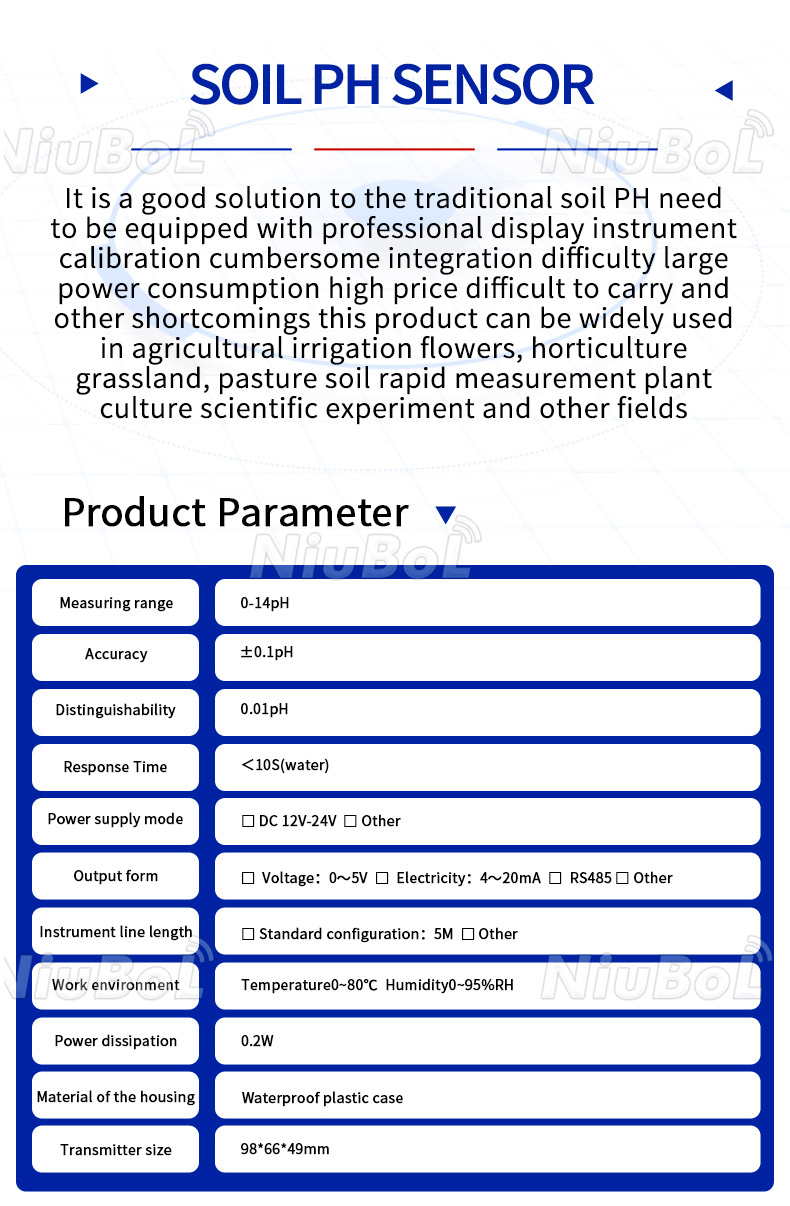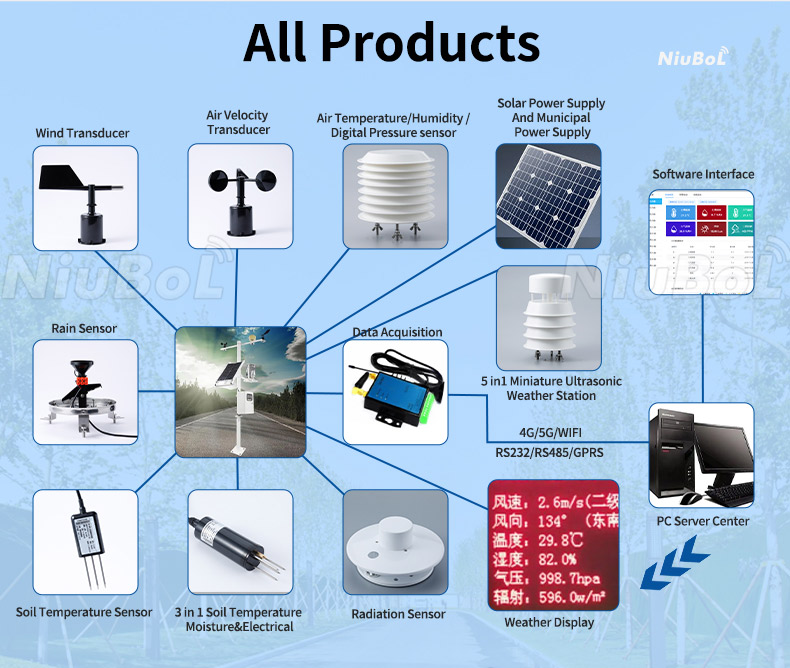

— Products —
 Consumer hotline +8618073152920
Consumer hotline +8618073152920 WhatsApp:+8615367865107
Address:Room 102, District D, Houhu Industrial Park, Yuelu District, Changsha City, Hunan Province, China
All products
RS485 soil sensors are sophisticated devices used for monitoring various soil parameters, including moisture content, temperature, pH, electrical conductivity (EC), and sometimes even more specific metrics such as soil redox potential. The RS485 interface these sensors employ is particularly notable for its robustness and reliability in field conditions, making it a preferred choice for agricultural, environmental monitoring, and smart irrigation applications.
Tel/WhatsApp:+8615367865107
Email:Arvin@niubol.com +Nearly 100 partner company in more than 68 countries. We are committed to providing high-quality, practical products to meet your needs and help you solve problems.Product Details
 |  |  |
| Soil NPK Sensor | Soil Moisture Temperature sensor | Soil salinity conductivity integrated sensor |
 |  |  |
| Soil pH sensor | Soil EC Sensor | 4-in-1 Soil Temperature Moisture EC Salt Sensor |





RS485 soil sensors are sophisticated devices used for monitoring various soil parameters, including moisture content, temperature, pH, electrical conductivity (EC), and sometimes even more specific metrics such as soil redox potential. The RS485 interface these sensors employ is particularly notable for its robustness and reliability in field conditions, making it a preferred choice for agricultural, environmental monitoring, and smart irrigation applications. Here's an overview of RS485 soil sensors, their benefits, and how they integrate into broader systems.
1. RS485 Communication Protocol: RS485 is a standard defining the electrical characteristics of drivers and receivers for use in serial communications systems. It enables long-distance data transmission and supports multiple devices on the same bus, making it ideal for connecting multiple soil sensors over large areas.
2. Soil Parameter Measurement:
- Moisture: The most common parameter, critical for irrigation management.
- Temperature: Affects microbial activity, seed germination, and plant growth.
- pH: Influences nutrient availability and soil chemistry.
- Electrical Conductivity (EC): Indicates soil salinity, which can affect plant health.
- Soil Nutrient Sensors(Soil NPK Sensors): Soil NPK sensors are devices used to measure the soil's nitrogen (N), phosphorus (P), and potassium (K) levels.These three nutrients are essential for plant growth and development, and their availability in the soil affects crop yield and quality.
- Others: Some sensors may measure additional parameters like soil redox potential or specific ion concentrations.
- Long-Distance Communication: RS485 allows for data transmission over distances up to 1200 meters, which is beneficial for large-scale farms or research plots.
- Multi-Device Capability: A single RS485 bus can support many devices, enabling comprehensive soil monitoring with fewer cables and simpler infrastructure.
- Noise Resistance: The differential signaling used by RS485 reduces susceptibility to electromagnetic interference, crucial in outdoor environments where long cable runs are common.
- Digital Data: Unlike analog sensors, RS485 soil sensors provide digital data, which can be more accurately and easily integrated into digital monitoring and control systems.
- Agriculture: Precision farming practices leverage RS485 soil sensors for data-driven irrigation, fertilization, and crop management, optimizing resource use and improving yields.
- Environmental Monitoring: These sensors contribute to monitoring ecosystems, studying climate change effects, and managing natural resources by providing detailed soil data.
- Smart Irrigation Systems: Integrated into smart irrigation networks, RS485 soil sensors can automate watering schedules based on real-time soil moisture data, enhancing water conservation efforts.
- Research: Scientists use these sensors in various studies related to soil science, agronomy, and environmental sciences to gather precise and reliable data over time.

Integrating RS485 soil sensors into a monitoring or control system typically involves:
- Wiring: Connecting the sensors to an RS485 bus, ensuring proper termination and polarity.
- Controller/Logger: A device that communicates with the sensors, collects data, and possibly controls other systems (like irrigation) based on the sensor data.
- Software: For data logging, visualization, and analysis. This can range from simple readouts to complex predictive modeling for crop management.
In summary, RS485 soil sensors offer a robust, scalable, and accurate means of monitoring soil conditions. Their integration into agricultural and environmental systems supports more informed decision-making, leading to better resource management and environmental stewardship.
Sensors & Weather Stations Catalog
Agriculture Sensors and Weather Stations Catalog-NiuBoL.pdf
Weather Stations Catalog-NiuBoL.pdf
Related recommendations
 Multi-Depth Soil Sensor RS485
Multi-Depth Soil Sensor RS485 TDR Soil Moisture Sensor
TDR Soil Moisture Sensor Pyranometer Solar Radiation Sensors
Pyranometer Solar Radiation Sensors Soil ph sensor
Soil ph sensor Tipping Bucket Rain Gauge
Tipping Bucket Rain Gauge Air Temperature and Humidity Sensor
Air Temperature and Humidity Sensor
Screenshot, WhatsApp to identify the QR code
WhatsApp number:+8615367865107
(Click on WhatsApp to copy and add friends)
